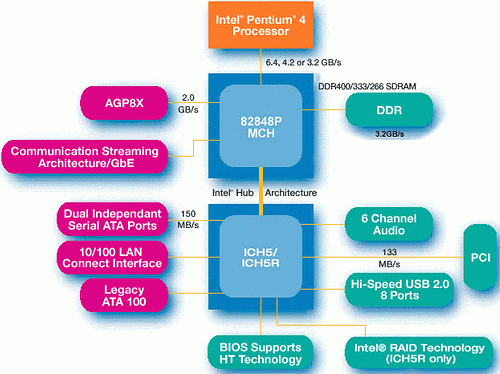 |
||
|
||
| ||
The severe economy has made it a worldwide trend not to throw away culled chips but use them in low-end products. They can have few pipelines, execution units, little cache, or they may not even support ceiling clocks, but the developers anyway try to find a niche for such chips. Such products are a good chance for the marketers to show their creativity! It's simple to speak about ultra-fashionable solutions, and it's quite a problem to outline advantages of such crippled samples. Today we are testing a new chipset from Intel for the Socket 478 platform (for Pentium 4) - i848P. If you do not remember the block diagram Intel uses for all chipset for the last 3-4 years, have a look at the i848P - it looks beautiful and colorful and shows a lot of clever words :).  The i848P looks like the i865PE, only with a single-channel DDR memory controller (or we can consider that it's the i865PE with some elements locked because the chip is the same). Taking into account that the i865PE is based on the i875P, just without the PAT and ECC supported, it's not difficult to imagine how it all works. The dies that pass all the tests are named i875P; those which have problems with PAT or do not support the highest clock speeds are named i865PE or i865P; finally, the dies that have only one controller channel is named i848P. Maybe I'm wrong. The cost price of the i875P is so low that it can be simpler for Intel to cripple the normal chips and sell them as i848P than to store the chips waiting for them to be sold out as expensive i875P. Anyway, they will never unveil the real state of affairs... Let's look through the key features of the i848P (the south bridges are the same in all Intel's chips, their features are described in the reviews mentioned above):
What's the difference from the i865PE? The chipset tested has one DDR controller channel instead of two and twice less RAM supported (and twice fewer memory modules supported). No more difference. That is why the maximum memory speed must be the only difference between these versions. HOwever, the maximum memory speed is not always needed. PerformanceTestbed:
Software:OS and drivers:
Test applications:
Test resultsWe don't expect much from the i848P. It must perform like a single-channel i865PE, that is why we used the test results of the i865PE based boards with the PAT enabled and disabled, as well as the ABIT BH7 board on the i845PE with the official support for the 800 MHz FSB and DDR400 (in the single-channel mode). Let's start the tests with calculations - they depend mostly on the CPU and pretty indifferent to the memory speed. 3ds max rendering Only the i865P with PAT enabled differs from the rest (it can be actually considered to be i875P). But the gap is not great, and we used this class of applications to show that MSI's Dynamic Overclocking technology (FSB on-the-fly overclocking in case of increased CPU load) doesn't boost performance at all - the i848P chipset is represented with the board exactly from MSI. Have a look at the gaming performance in the 3DMark2001 benchmark. The i845PE falls behind a little from the i848P and i865PE which go on a par, that is why we can't draw any conclusion on the comparative memory speed of these chipsets. The MPEG4 encoding doesn't make it clearer - only the i865PE with PAT enabled is again ahead. Let's have a look at the low-memory tests and see if there can be any difference between the chipsets at all. Now the i848P records and copies data faster than the i845PE but reads data from the memory slower. The dual-channel i865PE outscores its junior brother in this synthetic application, but the gap is not that great. But are there any real applications where it can prove its supremacy? The testbed is based on one of the most powerful processors in the line! That is why the difference will be even less noticeable on the slower CPUs and Celeron. In WinAce, a good memory performance test, the i848P and normal i865PE are equal again, that is why the latter can't boast of low latency. The i845PE falls much behind the new chipsets. The last interesting benchmark is the test packet for professional 3D graphic applications; this test loads both FSB and AGP bus. Those systems work faster the memory bus of which is wide enough to provide both buses with data. The diagram shows that the i865PE has some real advantage. Moreover, even the i845PE outscores the new-comer, probably because of the higher read speed. ConclusionThe i848P chipset is a crippled version of the i865PE - it lacks for a second memory controller channel and supports twice less memory and twice fewer memo modules. However, it's like removing an appendix because it doesn't affect much the performance. If you are not going to install over 2 GB RAM, and doesn't care for such inclonsiderable difference, the i848P can be a much better choice (especially if boards based on it are cheaper than those on the i865PE) than the i865PE! But why did Intel release such a powerful low-end competitor against its middle-end solution? Well, maybe the board makers will separate the niches of these chipsets by installing the i848P in very unsophisticated boards an the i865PE or even i875P into much more functional products... Or maybe, it's the right time for cheap chips from Intel?
Stanislav Garmatyuk (nawhi@ixbt.com) Dmitry Mayorov (destrax@ixbt.com) Write a comment below. No registration needed!
|
Platform · Video · Multimedia · Mobile · Other || About us & Privacy policy · Twitter · Facebook Copyright © Byrds Research & Publishing, Ltd., 1997–2011. All rights reserved. |